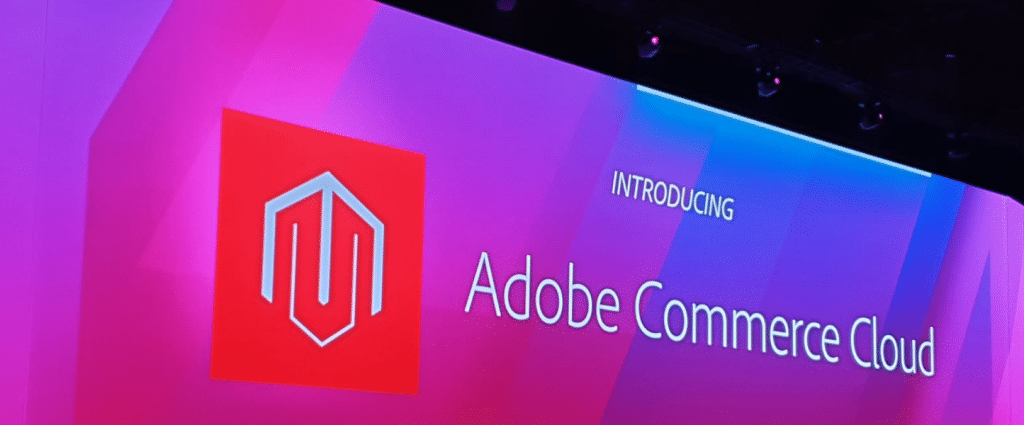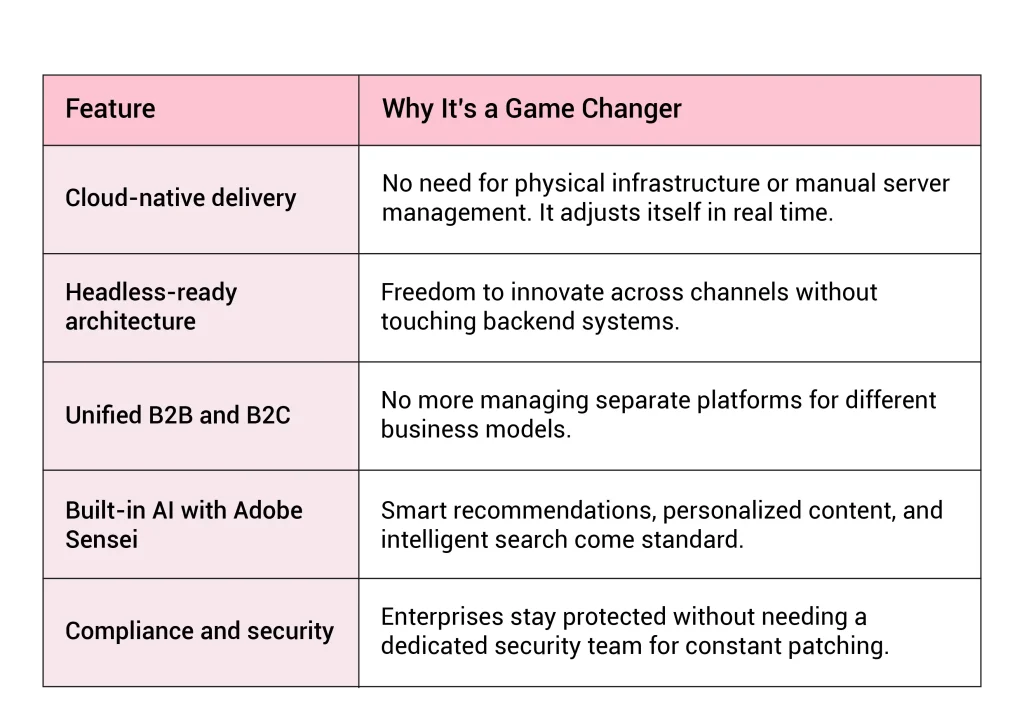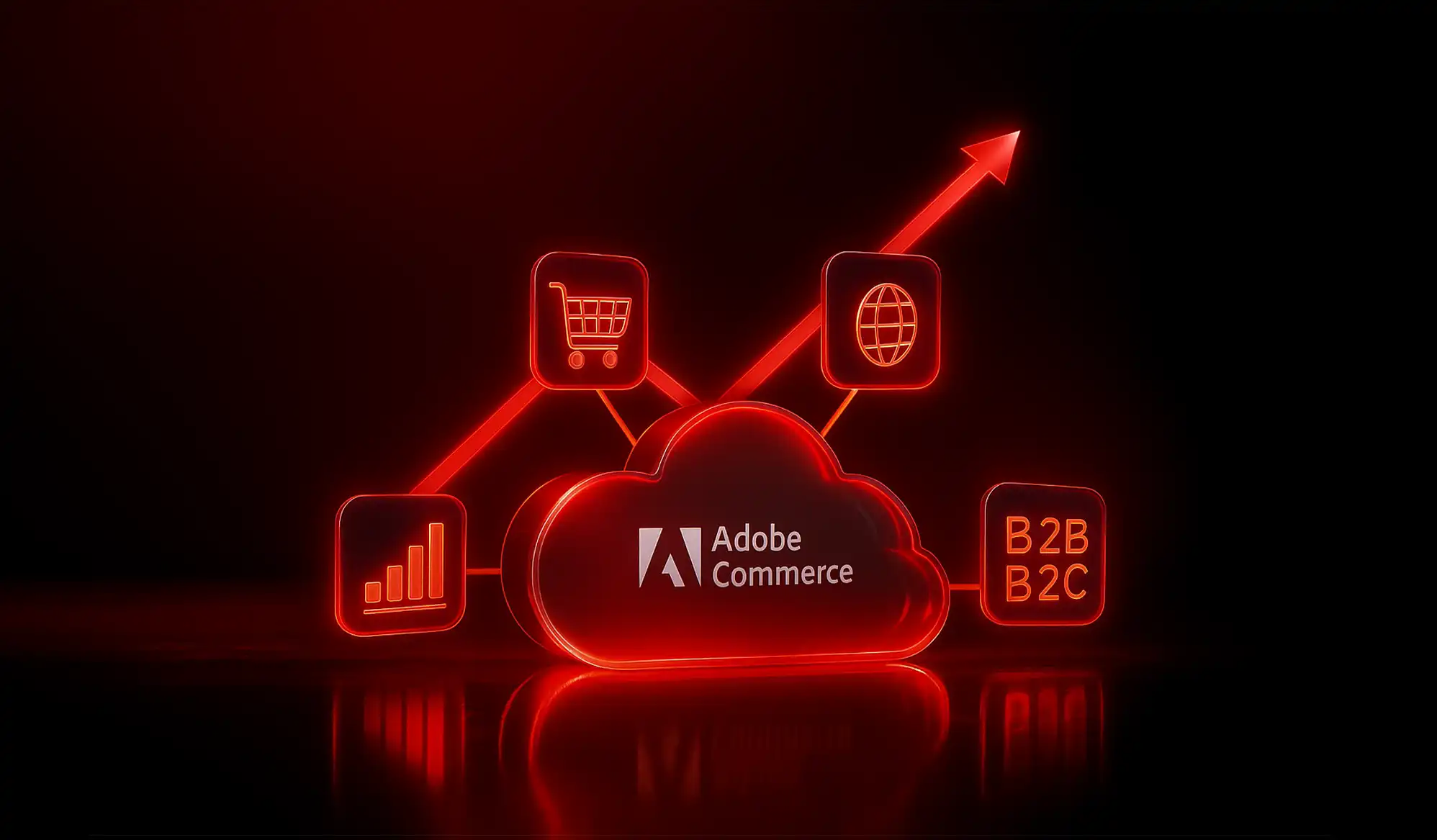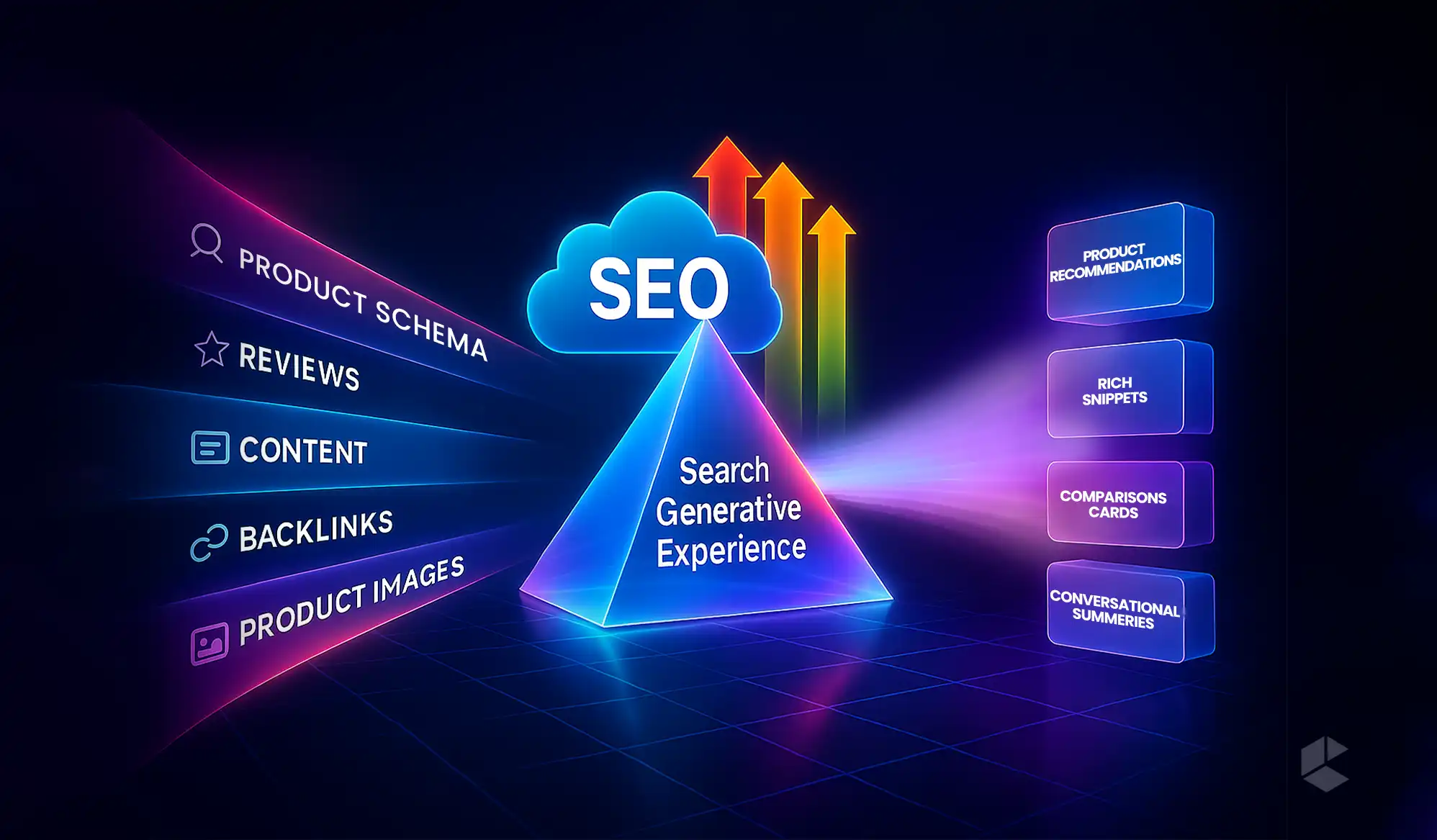- Handles traffic surges without breaking or slowing your storefront down
- Lets you run B2B and B2C without extra complications
- Plays nicely with Adobe’s marketing, content, and analytics stack
- Flexible enough to support any region, language, or customer type
- Real brands are seeing real results, not just small gains
- Built to grow with you, not hold you back later
In today’s digitally-first environment, enterprise-grade eCommerce platforms have to arm-wrestle a never-ending list of challenges. From increased traffic, rising customer demands, and bigger catalogs to growing security concerns, a lot of factors need to be taken care of. When it counts most, many outdated platforms just give up under strain.
Adobe Commerce Cloud is in the news for precisely this reason. There is more to this cloud-native powerhouse than just survival. It is intended to assist businesses in growing, adapting, and performing better. Consider it the high-end SUV of the eCommerce industry. It is long-lasting, feature-rich, and extremely powerful.
So, without further ado, let’s dive into why enterprises are making a switch to Adobe Commerce Cloud.
The Evolution of Ecommerce: From Optional to Essential
In the last decade, eCommerce has moved from just another channel to being the lifeblood of modern-day retail. In 2017, eCommerce accounted for just over 10% of global retail sales. But by 2023, this number had more than doubled! On top of that, the pandemic fueled the fire and truly accelerated this trend.
The consumers of today seek flawless digital journeys, including lightning-fast load times, consistency across different devices, and personalized experiences. Compared to that, if you offer an outdated platform, your business is meant to get rejected. You have to make the shift from manual to automation to survive and thrive in this cut-throat competition.
That is where Adobe Commerce Cloud comes in. This platform offers the right flexibility, features, and intelligence every enterprise needs today.
What Exactly Is Adobe Commerce Cloud?

Adobe Commerce Cloud is the evolved, enterprise-grade version of Magento Commerce. Now part of the Adobe Experience Cloud family, this platform helps businesses deliver high-impact, scalable eCommerce experiences.
The standout features include:
- A cloud-native architecture that adjusts to traffic automatically
- AI tools powered by Adobe Sensei that improve search and recommendations
- One unified platform that supports both B2B and B2C models
- Enjoy top-notch Adobe tool integrations like Experience Manager, Analytics, and Marketo
Key Capabilities That Enable Scale
Cloud-Native Infrastructure
Adobe Commerce Cloud is built on a scalable, managed cloud environment using Adobe’s Application Cloud Services. It automatically adjusts server capacity depending on traffic needs. No manual intervention. No downtime. Just reliable performance, even during peak events like holiday sales.
Headless and Modular by Design
For businesses that want custom storefronts using frameworks like React, Adobe offers headless commerce with GraphQL and REST APIs. The backend remains stable while the frontend evolves freely. That flexibility helps brands move faster and experiment without breaking the core system.
Built for B2B and B2C Together
Some platforms are good at retail. Others are built for wholesalers. Adobe Commerce Cloud does both. Whether it’s large-volume B2B orders with complex pricing or personalized promotions for everyday shoppers, the platform handles it in a single ecosystem.
Smarter Search and Merchandising
With Adobe Sensei that comes with Adobe Commerce Cloud, you can revolutionize search functionality that adds to your customer experience and overall sales. It can analyze user behavior and context to learn the possible search terms to be used by users. Owing to this, businesses get higher cart values, better conversions, and highly relevant results. Various enterprises have mentioned an average increase of up to 48% in order value because of this AI layer.
Developer-Centric Approach
From Git-based workflows to automated deployment tools, Adobe Commerce Cloud supports all this and more. Thanks to this, the DevOps teams are able to not only test various features but also track performance and deploy updates. This leads to fewer technical errors and more speed.
Why Enterprises Are Making the Shift
Better Customer Experiences
Adobe’s AI tools personalize every step of the buying journey. Whether it’s product recommendations, targeted offers, or smart search results, customers feel like the store is built just for them. That kind of personalization increases conversions and builds brand loyalty.
Seamless Adobe Integration
Adobe Commerce Cloud will fit into your system without any hassle if you are already using tools like Marketo, AEM, or Adobe Analytics. With Adobe Commerce Cloud, you can enjoy an uninterrupted data flow across operations, sales, and marketing, which will lead to less time spent on system sync and more time invested in building better campaigns.
Real-Time Data and Forecasting
You get a highly intuitive dashboard packed with features that help you monitor each and every aspect, from inventory to cart abandonment. Powered by predictive analytics, this dashboard helps every business with better planning, faster reaction, and inventory management.
Designed for Mobile
With a growing share of eCommerce happening on smartphones, Adobe Commerce ensures mobile responsiveness out of the box. Combined with CDN support and optimized delivery layers, it keeps page load times fast and bounce rates low.
Elastic Scalability
Whether you’re seeing a small surge from a flash sale or a massive spike during Black Friday, Adobe Commerce Cloud handles it without breaking a sweat. Enterprises don’t need to pre-purchase or manually allocate extra capacity. The platform scales as traffic grows, then contracts automatically.
Reduced Maintenance and Lower TCO (Total Cost of Ownership)
A major reason why many enterprises are shifting to Adobe Commerce Cloud is the simple fact that it’s lighter to maintain. There is no need to chase after every new patch and wake your IT team up at 2 AM for server problems. Adobe can take care of all the heavy lifting, from hosting and updates to security and so on.
This means that businesses do not need to waste their time and money on just keeping the lights on. There will be no more frequent upgrades and no more last second fire drills to deal with. Rather you can shift your focus towards marketing, customer experience, discovery, or something else that creates true impact. Ultimately, this hands-off attitude towards platform management accumulates genuine savings and a much cost-effective operation over time.
Enterprise-Level Security
Security is baked into the platform. It’s compliant with PCI Level 1 and SOC 2 standards. Data is encrypted both at rest and in transit. And with regular automated patching, businesses don’t need to worry about chasing vulnerabilities while hackers evolve.
Omnichannel, Multichannel, All-In-One
Adobe supports everything from online stores and marketplaces to social commerce and offline integrations. A business can unify its inventory, promotions, and fulfillment across every channel it operates in. Customers get a consistent experience, and operations stay in sync.
Regular Innovation
Adobe continues to roll out improvements, new tools, and integrations. Enterprises can keep pace with customer expectations without overhauling their tech stack every year.
Built-In B2B Features to Support Enterprise Commerce
B2B buyers do not behave like regular consumers! They need the structure, speed, and flexibility more than anything. And that’s exactly what Adobe Commerce has in store. The platform comes loaded with native B2B features that don’t need extra plugins or complicated custom builds. Everything’s right there, ready to go.
Account Structures That Match Real Companies
With Adobe’s company account system, your business customers can create teams inside their account. They can assign different roles to different users (like who can order, who can approve orders, and who can just view orders). It replicates a real-world business model, offering your clients the opportunity to run their business on their own terms, without relying on tech support for every single matter.
Pricing and Catalogs Tailored for Each Client
No two B2B buyers are the same. With Adobe Commerce Cloud, you can create custom catalogs and pricing models for every client. Want to show different SKU’s, corporate discounts, or hide products? All of that can be configured easily, without plugins or back-end hacks.
Simple Quote Requests Right from the Site
In B2B Commerce, negotiation is a part of big orders. Adobe has streamlined the buyer’s journey with the ability to request a quote during the shopping experience. Your sales team can then pick it up, make modifications, negotiate terms, and turn it into an order. And all happens from the same platform. No emails, no spreadsheets. Just a clean workflow.
Quick Ordering for People Who Know What They Want
A repeat customer shouldn’t have to click through a billion pages. Adobe’s quick order forms let buyers punch in SKUs directly, upload CSVs, or reorder from past purchases. It’s built for speed, especially when buyers already know what they need.
Approval Rules That Match Your Client’s Internal Processes
Big companies don’t just click and buy. Orders often go through approvals, and Adobe handles that too. You can set up custom approval flows—based on budgets, teams, departments, or anything else. Once configured, it all runs on autopilot, helping clients stay compliant with their own internal purchasing policies.
Clear Differentiators That Matter

How Enterprises Are Driving Scalable Growth with Adobe Commerce Cloud
Adobe Commerce Cloud isn’t just a well-dressed platform that sounds good on paper. Real enterprise brands across the globe are putting it to work and seeing measurable, bottom-line results.
Here are a few examples of how the platform is helping businesses unlock serious eCommerce scale.
Lexmark: From Legacy Infrastructure to Global Commerce Engine

Lexmark, a global leader in print and imaging products, was working with aging eCommerce systems that couldn’t keep up with their B2C and B2B ambitions. They needed a solution that could unify digital operations across regions while offering seamless experience management and faster rollout of updates.
They migrated to Adobe Commerce Cloud and integrated Adobe Experience Manager for headless content delivery.
The results were telling:
- 36% reduction in infrastructure costs
- 17% increase in average order value
- 300% growth in new customer registrations
Instead of managing regional silos, Lexmark now runs a global storefront architecture. The result is smarter personalization, more flexible deployment, and streamlined digital operations.
Watsco: Building a $900 Million Commerce Channel
As one of the largest HVAC distributors in the United States, Watsco knew digital commerce couldn’t just be a support function. It had to become a core revenue channel. With over 500 store locations and thousands of contractors depending on accurate inventory and fast ordering, Watsco turned to Adobe Commerce Cloud to streamline the entire buying journey.
The outcome was impressive:
- Over $900 million in annual eCommerce revenue
- 50% year-over-year digital growth
- Full support for 500+ locations and trade customers at scale
The platform helped Watsco build a robust B2B portal with real-time inventory, personalized catalogs, and mobile-first experiences for contractors in the field.
REDARC: Connecting Retail and Trade Customers Seamlessly
Australian electronics manufacturer REDARC needed a way to merge its B2C and B2B channels without duplicating effort or maintaining separate platforms. The company sells both to everyday customers and a network of trade partners across the automotive and marine industries.
With Adobe Commerce Cloud, REDARC launched a unified storefront experience tailored to both audiences.
Here’s what changed:
- Conversions doubled
- Trade accounts increased by 29%
- Retail engagement rose by 3.6%
By delivering personalized pricing, streamlined B2B checkout, and targeted campaigns through Adobe’s content tools, REDARC created a frictionless experience for both customer types without needing separate infrastructures.
What These Use Cases Prove
These companies weren’t looking for just another online store. They needed a scalable platform that could keep up with their growth, support complex business models, and deliver digital experiences that actually drive results.
Adobe Commerce Cloud helped them do just that.
Final Verdict: Who Should Use Adobe Commerce Cloud?
Adobe Commerce Cloud isn’t for every business. But for the right use cases, it’s a game-changer. If you check one or more of the boxes below, it’s worth serious consideration:
- You manage multiple storefronts or regions
- You need to support both B2B and B2C operations
- You want to personalize experiences at scale
- You face traffic surges and need auto-scaling infrastructure
- You already use Adobe products and want a connected ecosystem
- You’re planning long-term growth and need a platform that won’t hold you back
This isn’t a plug-and-play solution for a small startup with a few products. It’s built for enterprises that want more control, smarter insights, and better long-term ROI.
Conclusion
Scalability isn’t just about how many people your store can handle. It’s about how fast you can grow, how confidently you can launch new regions, and how well your tech can support big ideas. Adobe Commerce Cloud delivers that kind of scalability, plus the intelligence, security, and flexibility that modern enterprises demand.
FAQs
It’s built for complexity. Adobe Commerce Cloud handles high traffic, multi-brand operations, and heavy integrations without breaking a sweat. That’s why it works so well for large enterprises.
Yes, and that’s one of its best features. You can run B2B and B2C from one backend without juggling separate systems or duplicating product and customer data.
Of course! Not only do you get multi-currency support and localized storefronts, but you can also enjoy support for multiple languages, region-based tax rules, and a lot more from a unified system.
Adobe Commerce Cloud offers top-notch security. The platform is cloud-hosted, PCI-compliant, and includes features like encrypted transactions, role-based access control, and regular patches, which makes it a ‘safe’ choice for enterprises.
Adobe Commerce Cloud excels in customer experience, thanks to smart product recommendations, search functionality, and personalized content delivered with Adobe Sensei. This makes the buying journey easier and more enjoyable.









